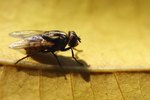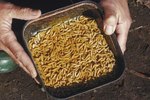
Your pipes provide the perfect home for sewer fly larvae, the immature forms of flies. Larvae find the goop that forms on the inside of your drain pipes particularly tasty. Once sewer fly larvae mature into fully grown flies, you’ll find the tiny flies buzzing around sinks, bathtubs, showers and drains.
Description
Sewer flies look like small moths. Long gray hairs cover their bodies and wings, which are large in comparison to their bodies. Sewer flies are approximately a sixth-inch to a fifth-inch long. They're also are called drain flies and moth flies. Despite their large wings, sewer flies aren’t strong fliers -- they can cover only an area of a few feet when they do fly. Sewer flies keep their wings over their bodies when they aren’t flying. The wings aren’t held directly against their bodies but form little pitched roofs over them.
Reproduction
Sewer flies look for organic material when it’s time to lay eggs. Preferred locations include pipes, stagnant water, birdbaths, sewers, bathtubs and other areas likely to have organic matter. The flies lay up to 200 eggs at a time. The eggs hatch approximately two days later. Sewer flies emerge from eggs as larvae. Special structures on the larvae act as suction cups and help them stick to slick surfaces. After feeding on slime and microorganisms inside drainpipe walls for two weeks, the larvae enter the pupal stage of development. They’ll grow wings and gradually change into mature sewer flies during this phase, which lasts only one or two days. The adult sewer fly has a short life span, living approximately two weeks. During that time, the female can lay many eggs.
Adult Flies
It can be difficult to keep sewer flies out of your home. They’re so small that they can fit through the tiny holes in the window and door screens. Sewer flies are most active at night. If you have an infestation, you might see them flying above sinks or drains once it gets dark. Sewer can travel some distance from the place where they hatch. The notes in some cases, the flies breed in sewage filter plants and are then carried by the wind to homes up to a mile away.
Disease Prevention
Sewer flies can carry bacteria on their bodies because they feed on decaying food and other organic matter. When they land on other surfaces, they can leave some of the bacteria. If you touch the bacteria, you could become sick. Thorough drain cleaning can rid your home of these pests. In addition to using drain cleaning solutions, clean the pipes with a long brush. If you don’t remove the sludge in the pipes, the flies will continue to reproduce.
References
Photo Credits
-
Jupiterimages/Photos.com/Getty Images
Writer Bio
Working at a humane society allowed Jill Leviticus to combine her business management experience with her love of animals. Leviticus has a journalism degree from Lock Haven University, has written for Nonprofit Management Report, Volunteer Management Report and Healthy Pet, and has worked in the healthcare field.



